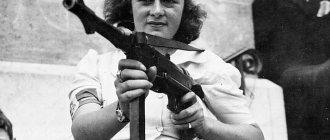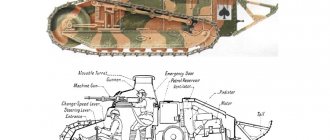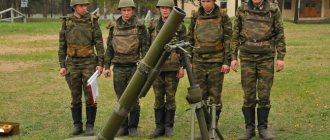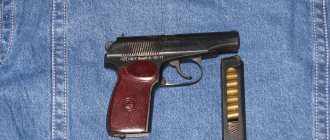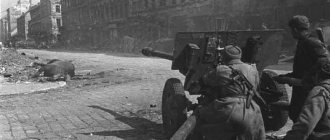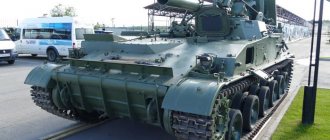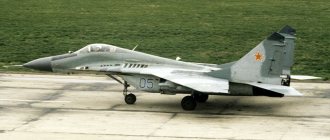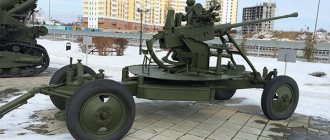All stages of human development are associated with continuous hostility and the seizure of foreign territories. Ancient cities were fortresses, the garrison of which was reliably protected by high walls. Often, the capture of such a fortification meant complete victory in the war. However, the long siege of cities was accompanied by very heavy losses on both sides.
It was necessary to create technical devices designed to destroy “serious” protection. Since the time of Alexander the Great, the first mentions of “ballistas” appeared - weapons capable of throwing stones along a suspended trajectory. This feature allowed the device, which was a type of catapult, to inflict damage on an enemy hidden behind a fortress wall.
At the end of the seventeenth century, the principle of the ballista was applied in the design of the mortar - a cannon that fired at an angle of 45 degrees. The successor to such a weapon was the mortar. Photos of the device, its types, combat qualities and technical characteristics are presented in the review. It also describes the history of the creation and stages of development of this type of weapon.
Historical reference
For the first time, a weapon that fired a mine shell, firing along a steep trajectory, was used by the Russian army in the war with Japan of 1904–1905, during the defense of the city of Port Arthur. The creator of the “close-range shooting apparatus” was officer and engineer Leonid Nikolaevich Gobyato.
The basis of the gun was a 75-mm howitzer with a cut-down barrel, adapted to fire ship mines. Subsequently, the new “miracle gun,” which in fact proved its excellent combat qualities, was called the “mortar.” The firing range of the gun depended on changes in the angle of the barrel, as well as the size of the charge, and ranged from 50 to 400 meters.
The Russian experience in using mortars was carefully studied by foreign experts. The devices were widely used during the World War of 1914–1918. In 1915, the army of Tsarist Russia received mortars of 47 and 58 mm caliber, which had a firing range of 400 and 520 meters, respectively. The creator of these devices was artillery captain E. A. Likhonin.
Mortar device
To understand how a mortar fires, you need to consider its design. The weapon has three main components:
- Trunk. A pipe-shaped element sets the direction of the projectile's flight. The top of the part is equipped with a socket (a) designed for convenient loading. The bottom of the barrel is a breech with a firing pin (c) pressed into it, which pierces the capsule of the projectile (mine).
- Base plate. The part has a hinged connection with the barrel. Serves as a support for the gun when firing, transmitting the recoil force to the surface (ground, chassis, etc.).
- Bipod. An element that supports the barrel when firing. It is folded into the stowed position using a spring latch (c).
Operating principle and range of the mortar
The impact mechanism of the mortar includes a firing pin mounted in the lower part of the barrel. The weapon charge - a mine - is supplied from the muzzle. The ammunition slides over a smooth surface, and its primer, located in the tail section, “pricks” onto the sting of the firing pin, which is why the shot occurs. This type of striker is called hard, it is extremely simple in design and can provide a high rate of fire.
The weapon's ammunition - a mine - has a drop-shaped body, equipped with an explosive warhead, with a stabilizing tail section. It houses the fuse, as well as the main (propelling) and additional charges, through the use of which the initial speed and range of the projectile is regulated.
In determining the distance at which a mortar is capable of firing, special tables created individually for each type of weapon help. Let's consider a typical example of such calculations.
Shooting table. Mortar 120-mm SAO 2S9
| Charge type | Charge weight (g) | Initial flight speed mines (m/sec) | Firing range (m) elevation angle 450 | Firing range (m) elevation angle 850 |
| No. 1 main | 100 | 120 | 1350 | 450 |
| No. 2 main + 1 additional | 170 | 160 | 2300 | 800 |
| No. 3 main + 2 additional | 240 | 190 | 3300 | 1150 |
| No. 4 main + 3 additional | 310 | 220 | 4200 | 1400 |
| No. 5 main + 4 additional | 380 | 250 | 4950 | 1650 |
| No. 6 main + 5 additional | 450 | 275 | 5750 | 1900 |
Thus, we can conclude: the projectile’s flight range depends not only on the size of the propellant charge, but also on the elevation angle of the gun. Note that the initial speed of the ammunition and the distance it can travel are also interrelated with the length of the mortar barrel.
Types of mortars
The most popular in the military industry was the 120 mm mortar of the 1943 model called PM-43, on the basis of which a large number of modern modifications were developed:
- 2B11 - standard version;
- 2B24 - a domestic modification that is significantly superior in fire performance to all imported analogues; 2B11 - modification, licensed under license in Bulgaria;
- 2S12 - is a mortar complex called “Sani”. Its design is represented by the 2F510 vehicle (GAZ-66 vehicle), on which the installation is transported, and the 2L81 wheel drive, intended for use with the standard version of the 2B11 mortar;
- 2K32 - 2B24 class mortar is located on an armored tracked base;
- 2B25 - used by special units. It has a number of advantages that allow it to carry out attacks in which the enemy cannot determine the location of the installation and, as a result, eliminate it. It is also available in the “Commandos” version with a firing range of up to 3 km and a total weight of the structure not exceeding 12 kg.
Mortars. Characteristics of guns, their goals and objectives
In combat, great importance is attached to the mobility of fire weapons, the possibility of their use in forward positions, the lethal effect of weapons and their ability to camouflage. The mortar fully meets these requirements. Being a weapon with a mounted firing trajectory, it provides:
- Destruction of enemy manpower located in open areas, as well as in trenches, trenches, gorges and ravines, behind vertical walls and heights.
- Installation of smoke screens to facilitate the covert redeployment of friendly units.
- Illumination of the area in order to “blind” the enemy.
Combat qualities of the mortar
- High rate of fire. The devices are characterized by easy reloading, which allows firing from guns with high intensity. The rate of fire of some types of modern mortars is up to 170–190 rounds per minute.
- High power multi-purpose ammunition. Fragmentation, high-explosive, cluster, incendiary, smoke and light are just some of the types of shells that a mortar can fire. The firing range of the gun is adjusted by changing the power of the charge that pushes the mine out of the barrel.
- Simple device. The convenient design of most mortars, the ability to disassemble them and ease of transportation allow the guns to be moved over rough terrain, continuously supporting their units with fire. Some models can be used for shooting from the back of a car.
- Constant combat readiness. Mortars are characterized by a high speed of bringing into a “working” state due to the ease of assembly.
- Steep trajectory of the projectile. The gun is capable of hitting a closed target protected from flat artillery and machine-gun fire. Thanks to this feature, the mortar is capable of firing “above” its own units.
Main varieties of 120 mm mines used in 2B11
The performance achieved by the 120 mm mortar, the characteristics of which are indicated for 5 people, has been significantly improved in recent years at the Burevestnik Central Research Institute. Now the structure is transported on URAL-43206 vehicles and armored tracked MT-LB, allowing the accompanying crew to be guaranteed the maximum degree of protection.
Main mines used:
- high-explosive fragmentation with a weight of up to 15.9 kg;
- incendiary;
- smoke;
- lighting;
- propaganda
At the same time, the time that must be spent taking up a firing position if necessary is 8 minutes, and in order to leave it, it will take about 6 minutes.
Classification
Let's briefly look at the types of guns, using Russian mortars as a basis. Since the times of the USSR, this type of weapons has been classified as follows:
- Company guns (caliber 55–65 mm).
- Battalion (80–85 mm).
- Regimental (105–125 mm).
- Divisional (large-caliber and jet).
Mortars are distinguished by their barrel design as smooth-bore guns and rifled guns. There are two ways to load them - from the muzzle and breech. The degree of automation of recharging also varies. There are automatic weapons, for example, the 2B9M “Cornflower” - a mortar, the photo of which is presented below.
There are self-propelled mortars - mounted on a wheeled or tracked chassis.
Development of tools
The most important stage in the development of mortars was the Second World War of 1939–1945. The USSR industry alone produced over 345,000 of these guns! Naturally, it is necessary to remember the famous “Katyusha” BM-13 - the first Guards rocket mortar. The firing range of this gun ranged from 4350 to 5500 m.
The main characteristics of the mortars of that time, which were in service with the countries participating in the war, are summarized in this table.
| Types of mortars | Gun caliber (mm) | Weight in firing position (kg) | Mine weight (kg) | Gun firing range (m) |
| Company commanders | 50-65 | 9-20 | 0,8-1,5 | 420-1800 |
| Battalion | 80-85 | 50-65 | 3,0-4,5 | 2400-3700 |
| Regimental | 105-120 | 170-280 | 9-17 | 3700-6200 |
| Divisional | 160 | 1170 | 40,5 | 5500 |
Links[edit]
- Rottman, Gordon L. (December 2002). The Korean Military Order of Battle: The United States, the United Nations, and the Communist Land, Navy, and Air Forces, 1950–1953
. Praeger. p. 198. ISBN 978-0-275-97835-8. Archived from the original on December 9, 2022. Retrieved June 1, 2022. - Rottman, Gordon L. (February 10, 2009). North Vietnamese Army Soldier 1958–75
. Warrior 135. Osprey Publishing. paragraph 32. ISBN 9781846033711. - Campbell, David (November 30, 2022). Soviet Paratrooper Against the Mujahideen: Afghanistan, 1979–89
. Fight 29. Osprey Publishing. pp. 19, 77. ISBN 9781472817648. - Military Balance 2016, p. 492.
- "120-HM 38". Encyclopédie des armes: Les forces armées du monde
(in French).
IX
. Atlas. 1986. pp. 2042–2043. - ^ a b c
US Army,
FM 100-2-3 The Soviet Army: Troops, Organization and Equipment
, 5–60 - ^ a b c d
"120 mm Type 53 mortar".
Jane's Infantry Weapons 2002-2003
. March 15, 1992 pp. 1295–1296. - "NORINCO Type 55 120mm Mortar". Jane's Infantry Weapons 2002-2003
. June 4, 2001, pp. 1295–1296. - "Helwan 120mm heavy mortar Model UK 2". Jane's Infantry Weapons 2002-2003
. 4 June 2001. pp. 1617–1618. - Bhatia, Michael Vinay; Sedra, Mark (May 2008). Small Arms Review (ed.). Afghanistan, Arms and Conflict: Armed Groups, Disarmament and Security in Post-War Society
. Routledge. paragraph 66. ISBN 978-0-415-45308-0. Archived from the original on September 1, 2022. Retrieved June 1, 2022.CS1 maint: ref=harv (link) - ^ a b c d e f g h i j k l m n
“120 mm M-43 mortar”.
Jane's Infantry Weapons 2002-2003
. June 4, 2001, pp. 3682–3683. - Military Balance 2016, p. 320.
- "National Inventories, Bangladesh". Jane's Infantry Weapons 2001-2002
. November 22, 2000 p. 819. - Military Balance 2016, p. 431.
- Military Balance 2016, p. 239.
- Military Balance 2016, p. 435.
- Military Balance 2016, p. 436.
- Military Balance 2016, p. 438.
- Military Balance 2016, p. 393.
- Military Balance 2016, p. 324.
- Military Balance 2016, p. 449.
- Military Balance 2016, p. 450.
- Military Balance 2016, p. 400.
- Military Balance 2016, p. 107.
- Rottman, Gordon L. (1993). Armies of the Gulf War
. Elite 45. Osprey Publishing. P. . ISBN 9781855322776. - Small Arms Review (2012). "Blue skies and black clouds: Kazakhstan and small arms". 2012 Small Arms Review: Moving Targets
. Cambridge University Press. item 131. ISBN. 978-0-521-19714-4. Archived from the original (PDF) on August 31, 2018. Retrieved June 1, 2022. - US Department of Defense. "120-mm mortar M-1943." North Korea Handbook, 1997, Appendix A: Equipment Recognition
(PDF). item A-91. Archived (PDF) from the original on 03/04/2016. Retrieved June 1, 2022. - Military Balance 2016, p. 265.
- Military Balance 2016, p. 271.
- Military Balance 2016, p. 454.
- Military Balance 2016, p. 458.
- Military Balance 2016, p. 276.
- Military Balance 2016, p. 277.
- Military Balance 2016, p. 406.
- Military Balance 2016, p. 469.
- Military Balance 2016, p. 471.
- Military Balance 2016, p. 289.
- Military Balance 2016, p. 354.
- Military Balance 2016, p. 297.
- Military Balance 2016, p. 478.
- International Institute for Strategic Studies (February 2016). Military Balance 2016
.
116
. Rutleghe. ISBN 9781857438352.
Modern guns
Today's mortars, thanks to the rapid development of military-industrial technologies, have turned into ultra-modern rifle systems. We will not describe in detail all the advantages of artillery guns of the 21st century, but will consider only one model. And in her example we will see how far progress has stepped forward.
At the military-technical exhibition MILEX-2011, held in Minsk, Russian engineers presented a silent mortar 2B25, called “Gall”. The peculiarity of this product is that it has the most covert combat use. When a mortar is fired, the powder gases are “locked” in the ammunition, and the weapon does not emit smoke, sound or a shock wave.
"Gall" hits targets at a range of 1000–1300 m with a rate of fire of 15 rounds/min. The weight of the mortar does not exceed 15 kg, and the mass of the projectile is only 1.9 kg. 2B25 is designed to support the work of special forces and has no analogues in the world.
Basic data
The 120 mm mortar, whose destruction radius when firing guided mines reaches 9000 m, is by far the most effective weapon for suppressing enemy firepower and covering the movement of infantry units.
Firing is carried out using mortar rounds with GVMZ-7 class fuses and a variable charge. It is noteworthy that the 2F510 vehicle (GAZ-66 car) with a V-shaped 8-cylinder engine, in which the 2B11 is transported, can transport with it only a strictly defined supply of charges, placed in 24 boxes. The ammunition is designed to fire 48 shots, which can be fired by a 120 mm mortar. The characteristics of the device allow loading and unloading 2B11 into the body of a car without the use of heavy equipment.
If for some reason there are not enough people to carry out this procedure, the mortar is transported in tow. At the same time, the 2F510 engine is gasoline and belongs to the ZMZ-66-06 class, the power of which reaches 120 hp. With. In this case, the maximum permissible speed on the highway is 90 km/h.
If a vehicle with a mortar launcher must ford a river, preliminary measurements will have to be taken for the vehicle to pass normally. In the deepest place, the maximum permissible water level should not exceed 1 m.
The brake system is equipped with a hydraulic drive with several circuits and hydraulic vacuum boosters on each of them. These factors make it possible to ensure reliable transportation of the 2B11 even in difficult combat conditions. The only weakness of the 2F510 is the dependent suspension on polyelliptic springs with shock absorbers.
